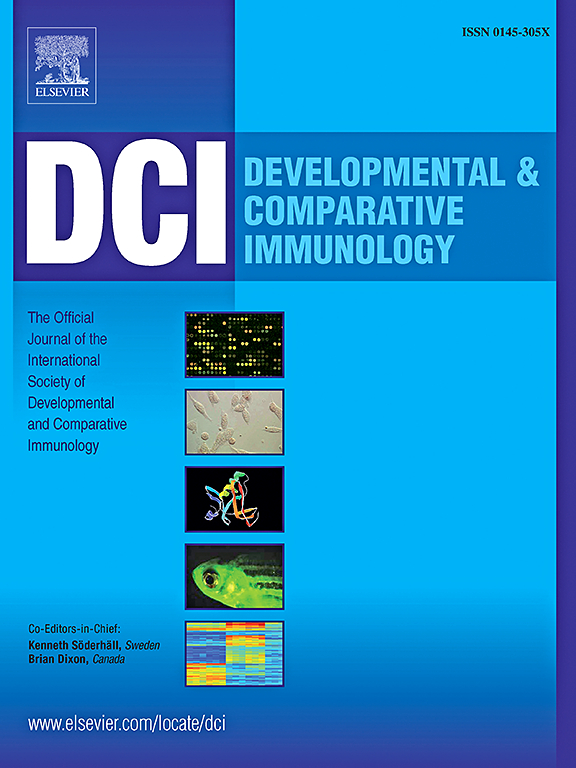结合转录组学和代谢组学研究中华鳖感染出血性综合征病毒(TSHSV)的致病机制
IF 2.4
3区 农林科学
Q1 FISHERIES
引用次数: 0
摘要
中华鳖出血性综合征病毒(TSHSV)致死率高,严重阻碍了中华鳖的养殖。然而,TSHSV在中华按蚊中的致病机制尚不清楚。本研究对TSHSV感染后的海龟肝脏进行了转录组学和代谢组学分析。不同TSHSV攻毒组共鉴定出734个差异表达基因(deg)上调,770个差异表达基因(deg)下调。这些deg被归类为与病毒感染和宿主免疫相关的12种途径。此外,D1、D3和D5组分别鉴定出27、2679和4341个差异表达代谢物(DEMs)。这些dem被映射到能量代谢、氨基酸代谢和脂肪酸代谢途径中。关联分析显示,TSHSV诱导炎症反应,肝细胞凋亡,最终导致肝组织损伤。补充牛磺酸可通过调节干扰素、抗氧化酶和促炎细胞因子TNF-α的产生,提高TSHSV感染后海龟的存活率,降低肝脏的炎症反应。总的来说,我们的研究结果提供了TSHSV入侵后中国软壳龟肝脏转录组和代谢组的全面概况,揭示了潜在的致病机制。补充牛磺酸的方法可能是一种有前途的治疗策略,以保护海龟免受TSHSV。本文章由计算机程序翻译,如有差异,请以英文原文为准。
Integrating transcriptomics and metabolomics revealed pathogenic mechanism of Chinese soft-shell turtle (Trionyx sinensis) infected with Trionyx sinensis hemorrhagic syndrome virus (TSHSV)
Trionyx sinensis Hemorrhagic Syndrome Virus(TSHSV)seriously hinders the aquaculture of Chinese soft-shell turtle (Trionyx sinensis) due to its high mortality. However, the pathogenic mechanisms of TSHSV in T. sinensis are still unclear. In present study, transcriptomic and metabolomic analyses were performed on turtle livers following TSHSV infection. 734 up-regulated and 770 down-regulated differentially expressed genes (DEGs) were identified in different TSHSV challenge groups. These DEGs were categorized into 12 pathways related to virus infection and host immunity. Moreover, 27, 2679, and 4341 differentially expressed metabolites (DEMs) were identified in the D1, D3, and D5 groups, respectively. These DEMs were mapped into the pathways of energy metabolism, amino acid metabolism and fatty acid metabolism. Association analysis revealed TSHSV induced inflammatory responses, hepatocyte apoptosis, and ultimately led to liver tissue damage. Taurine supplementation promoted the survival rate of turtle after TSHSV infection and reduced the inflammatory response of liver by regulating the production of interferons, antioxidases, and the pro-inflammatory cytokine TNF-α. Collectively, our results provide comprehensive profiles of the transcriptome and metabolome in Chinese soft-shell turtle liver after TSHSV invasion, shedding light on the underlying pathogenic mechanism. The method of taurine supplementation might be a promising therapeutic strategy for protecting turtles from TSHSV.
求助全文
通过发布文献求助,成功后即可免费获取论文全文。
去求助
来源期刊
CiteScore
6.20
自引率
6.90%
发文量
206
审稿时长
49 days
期刊介绍:
Developmental and Comparative Immunology (DCI) is an international journal that publishes articles describing original research in all areas of immunology, including comparative aspects of immunity and the evolution and development of the immune system. Manuscripts describing studies of immune systems in both vertebrates and invertebrates are welcome. All levels of immunological investigations are appropriate: organismal, cellular, biochemical and molecular genetics, extending to such fields as aging of the immune system, interaction between the immune and neuroendocrine system and intestinal immunity.

 求助内容:
求助内容: 应助结果提醒方式:
应助结果提醒方式:


